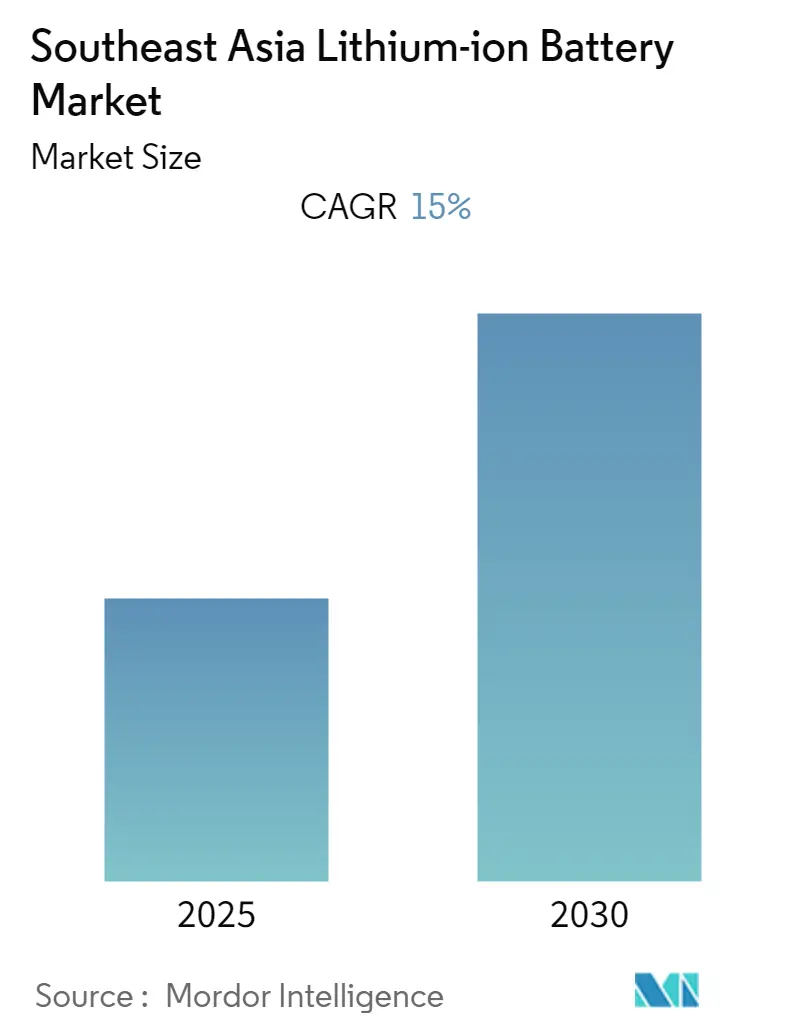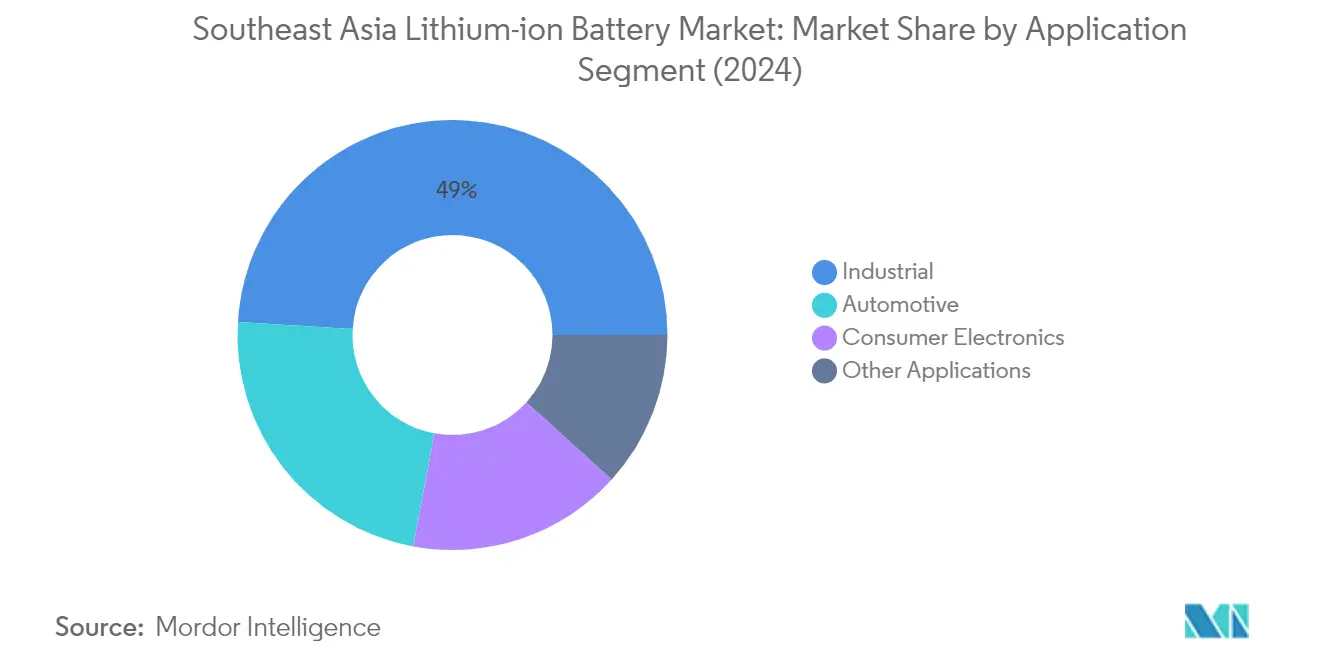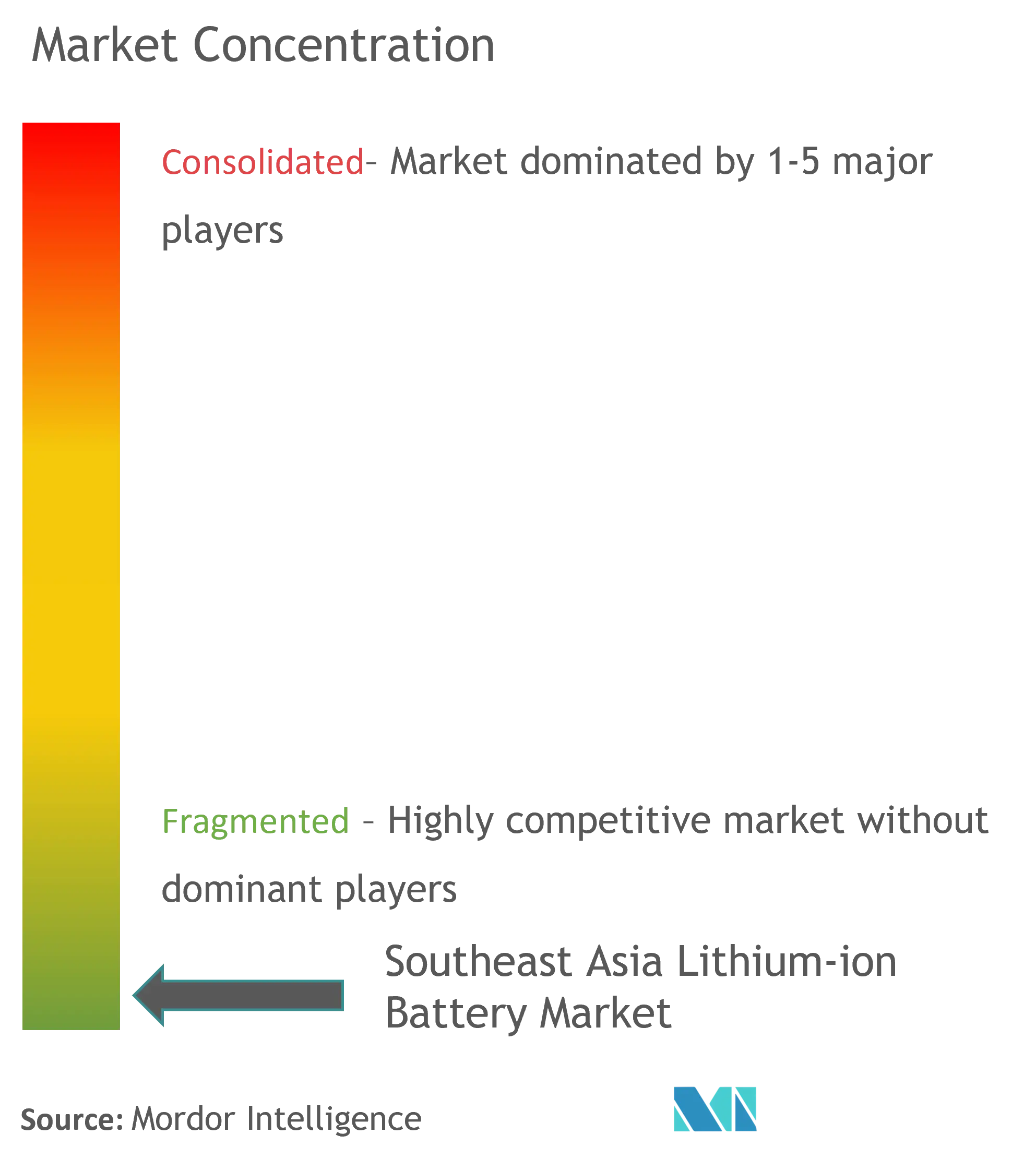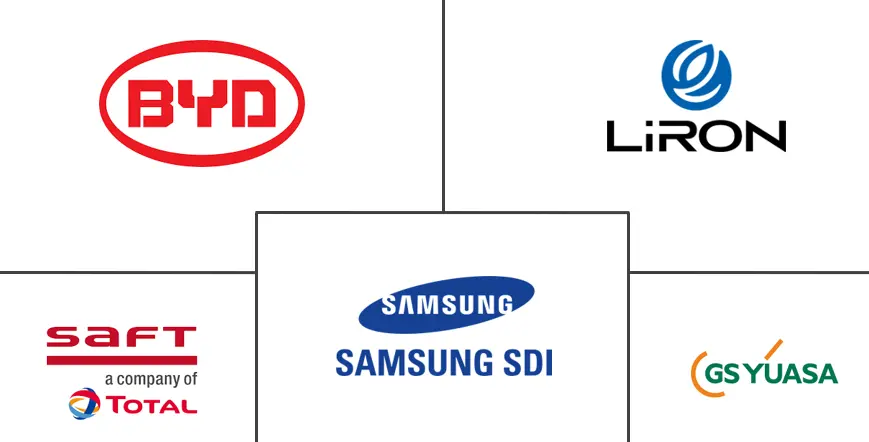
Southeast Asia Lithium-ion Battery Market Analysis by Mordor Intelligence
The Southeast Asia Lithium-ion Battery Market is expected to register a CAGR of 15% during the forecast period.
The Southeast Asian lithium-ion battery landscape is experiencing significant technological advancement and infrastructure development. Major manufacturers are introducing innovative battery technologies to meet evolving market demands. In August 2023, CATL launched Shenxing, the world's first 4C superfast charging LFP battery, capable of delivering 400 km of driving range with a 10-minute charge. The region's data center infrastructure is expanding rapidly, with 352 facilities operational as of September 2023, driving demand for reliable energy storage batteries solutions. Singapore's data centers alone account for 7% of the country's total electricity consumption, highlighting the growing energy storage requirements in the digital infrastructure sector.
Manufacturing capabilities across Southeast Asia are expanding through substantial investments from global industry leaders. In July 2023, Chinese battery manufacturer EVE Energy announced plans to establish a USD 422 million production facility in Malaysia's Kulim region, focusing on cylindrical lithium-ion battery cells for electric two-wheelers. Similarly, in Thailand, BYD announced an investment of THB 17.9 billion to construct a new facility capable of producing 150,000 passenger electric cars annually from 2024. These investments are transforming the region into a significant hub for battery and electric vehicle production.
The integration of advanced battery technologies across various industries is reshaping the market landscape. In May 2023, Dyson Group revealed plans to establish an advanced manufacturing plant for next-generation batteries in Singapore's Tuas industrial district, with production scheduled to commence in 2024. The 23,000-square-meter facility represents a significant step toward developing more sophisticated battery cell solutions. The telecommunications sector is witnessing substantial growth, with Ericsson forecasting 5G users in Southeast Asia and Oceania to reach over 600 million by 2028.
The market is characterized by increasing domestic manufacturing capabilities and technological collaboration. In February 2023, Hong Seng Consolidated Bhd announced plans to develop an EV battery manufacturing plant in Malaysia's Tanjung Malim, partnering with EoCell Inc (USA) for battery production. This facility aims to supply EV batteries to manufacturers in Proton City, Malaysia's largest automotive manufacturing hub. The industry is witnessing a shift toward more advanced battery chemistries, with manufacturers focusing on high-nickel-manganese-cobalt (NMC 811) batteries and lithium iron phosphate (LFP) technologies to meet diverse application requirements across different sectors.
Southeast Asia Lithium-ion Battery Market Trends and Insights
Increasing Adoption of Lithium-Ion Batteries in Electric Vehicles
The automotive sector across Southeast Asia is witnessing a significant transformation driven by the increasing adoption of electric vehicles (EVs), which is subsequently propelling the demand for lithium-ion battery systems. Lithium-ion battery systems have emerged as the preferred technology for plug-in hybrid and electric vehicles due to their superior characteristics, including high energy density, fast recharge capability, and high discharge power. These rechargeable battery systems are currently the only available technology that effectively meets OEM requirements for vehicles' driving range and charging time, making them significantly more advantageous than traditional lead-based traction battery systems, which are hampered by lower specific energy and higher weight constraints.
Government support across the region has been instrumental in accelerating EV adoption through various initiatives and incentives. For instance, in 2023, Indonesia announced plans to offer substantial subsidies exceeding USD 5,000 on every electric car sale, specifically for EVs produced by companies with local manufacturing facilities. Similarly, the Philippine government implemented a significant policy change by reducing import duties on electric vehicles from 5-30% to 0% to stimulate EV adoption. Thailand has also demonstrated strong commitment through its National Electric Vehicle Policy Committee (NEVPC) roadmap, which aims to introduce between 400,000 and 750,000 EVs by 2026.
The automotive manufacturing landscape in Southeast Asia is experiencing substantial investments in EV production facilities, which is directly driving the demand for electric vehicle battery systems. For example, in July 2023, Chinese EV manufacturer BYD announced an investment of THB 17.9 billion to establish a new facility in Thailand that will produce 150,000 passenger electric cars annually from 2024, with plans to export to Southeast Asia and Europe. Additionally, in August 2023, Eve Energy Malaysia initiated the construction of a USD 422.3 million battery manufacturing facility in Kulim, Kedah, focusing on producing cylindrical lithium-ion battery systems for electric two-wheelers. These developments are creating a robust ecosystem for lithium-ion battery production and consumption in the automotive sector.
The shift towards electric mobility is particularly pronounced in the two-wheeler segment across Southeast Asia. In Indonesia, electric two-wheelers captured 10% of the market in recent years, with nearly 1.8 million electric motorcycles and scooters in operation, making it the second-largest market globally for two-wheeler electrification after China. This trend is supported by the fact that the price difference between conventional and electric two-wheelers is significantly lower compared to four-wheelers, making them more accessible to a broader consumer base. For instance, in Indonesia, while Electric Four-Wheelers (E4Ws) are typically priced above IDR 600 million compared to internal combustion engine vehicles under IDR 300 million, the price gap for two-wheelers is much narrower, making them an attractive option for consumers.
Segment Analysis: By Application
Industrial Segment in Southeast Asia Lithium-ion Battery Market
The industrial segment maintains its dominance in the Southeast Asia lithium-ion battery market, commanding approximately 49% of the total market share in 2024. This substantial market presence is driven by the increasing adoption of industrial battery solutions in various applications, including battery energy storage systems (BESS), telecom towers, data centers, and material handling equipment. The segment's growth is particularly notable in countries like Indonesia, Vietnam, and Thailand, where significant investments are being made in renewable energy infrastructure requiring energy storage battery solutions. Major industrial players are actively expanding their BESS capabilities, with companies like San Miguel Corp implementing ambitious deployment plans spanning multiple locations. The segment also benefits from the rapid expansion of data center facilities across the region, particularly in Singapore, Malaysia, and Indonesia, where lithium-ion battery systems are increasingly preferred for uninterruptible power supply (UPS) systems.

Automotive Segment in Southeast Asia Lithium-ion Battery Market
The automotive segment is emerging as the fastest-growing segment in the Southeast Asia lithium-ion battery market, with an expected growth rate of approximately 32% during 2024-2029. This remarkable growth is primarily driven by aggressive electric vehicle (EV) adoption targets set by various Southeast Asian nations and supportive government policies promoting EV manufacturing and adoption. Thailand's ambitious goal to transform into an EV manufacturing hub, targeting 30% of total auto production by 2030, exemplifies this trend. Indonesia's strategic advantage in nickel resources is attracting significant investments in EV battery pack manufacturing, while Vietnam's emerging EV market is witnessing rapid expansion with both domestic and international players. Malaysia's target of achieving over 1.5 million electric vehicles by 2040 and Singapore's comprehensive EV roadmap further contribute to the segment's accelerated growth trajectory.
Remaining Segments in Southeast Asia Lithium-ion Battery Market
The consumer electronics and other applications segments continue to play vital roles in shaping the Southeast Asia lithium-ion battery market landscape. The consumer electronics segment is driven by the region's growing middle class, increasing smartphone penetration, and rising demand for portable battery electronic devices. This segment benefits from the establishment of manufacturing facilities by major electronics companies in countries like Vietnam and Thailand. The other applications segment, which includes medical devices and power tools, is gaining traction due to infrastructure development projects and healthcare sector modernization across Southeast Asia. The construction industry's growth, particularly in Indonesia, Vietnam, and the Philippines, is driving demand for industrial battery powered tools and equipment, while the healthcare sector's expansion is increasing the need for portable medical devices powered by consumer electronics battery systems.
Southeast Asia Lithium-ion Battery Market Geography Segment Analysis
Lithium-ion Battery Market in Vietnam
Vietnam has established itself as the dominant force in Southeast Asia's lithium-ion battery market, commanding approximately 64% of the regional market share in 2024. The country's strategic advantage stems from its abundant high-quality nickel reserves, which have become increasingly attractive to international mining companies. The electric vehicle explosion has particularly stimulated demand for raw materials like nickel, a key component in lithium-ion batteries. Vietnam's success is further bolstered by its rapid industrialization and transition from a primarily agricultural economy to a diversified and advanced industrial base. The country has witnessed significant investments in battery manufacturing facilities, with companies like VinFast leading the domestic market while foreign companies such as KIA, Mercedes-Benz, and Toyota establish their presence. The government's supportive policies, including free registration and excise tax reduction from 15% to 3%, have created a conducive environment for the EV industry, subsequently driving the demand for lithium-ion batteries.
Lithium-ion Battery Market in Indonesia
Indonesia is positioned to experience remarkable growth in its lithium-ion battery market, with a projected CAGR of approximately 15% from 2024 to 2029. The country's growth trajectory is supported by its position as Southeast Asia's largest economy and its wealth of natural resources, particularly in battery materials. Indonesia's strategic advantage lies in possessing 25% of global nickel resources, making it a crucial hub for battery production. The government has implemented various supportive policies and regulations, including the Presidential Regulation aimed at accelerating battery electric vehicle adoption. The country has also established the Indonesia Battery Corporation (IBC) through a partnership of four state-owned companies to scale up the battery industry and attract foreign investment. The domestic market is further strengthened by the government's ban on nickel ore exports, ensuring supplies for the domestic industry and attracting significant investments across the entire supply chain.
Lithium-ion Battery Market in Thailand
Thailand has emerged as a pivotal player in Southeast Asia's lithium-ion battery market, leveraging its position as the region's leading car production base. The country's success is built on its 50-year evolution from an auto component assembler to a leading automotive production and export center. Thailand's strategic approach includes comprehensive government support through various incentives, including discounts for EV buyers and subsidy schemes for manufacturers. The country has attracted significant investments from global battery manufacturers, with several companies establishing production facilities to serve both domestic and export markets. Thailand's commitment to becoming an EV hub is evident in its ambitious targets and the development of a robust supply chain ecosystem. The market is further strengthened by the presence of supporting industries, including industrial battery manufacturers and recycling companies, creating a comprehensive value chain for lithium-ion battery production and utilization.
Lithium-ion Battery Market in Singapore
Singapore has positioned itself as a technology and innovation hub for the lithium-ion battery market in Southeast Asia, leveraging its advanced infrastructure and pro-business environment. The country's strategic location and sophisticated technological ecosystem have attracted major investments in battery technology research and development. Singapore's approach to market development is characterized by its comprehensive Green Plan 2030, which includes significant initiatives to promote electric vehicle adoption and charging infrastructure development. The country has also established itself as a crucial center for battery technology innovation, with various research institutions and companies focusing on developing next-generation battery solutions. Singapore's success is further supported by its robust data center industry, which creates substantial demand for energy storage battery systems, and its strategic partnerships with global technology leaders in the battery sector.
Lithium-ion Battery Market in Other Countries
The remaining Southeast Asian countries, including Malaysia, the Philippines, Cambodia, Laos, Myanmar, and Brunei, collectively represent an emerging market with diverse growth opportunities in the lithium-ion battery sector. These countries are at various stages of market development, with each pursuing unique strategies to establish their presence in the regional battery ecosystem. Their market dynamics are shaped by factors such as government policies supporting electric vehicle adoption, investments in renewable energy infrastructure, and growing industrial applications. While these markets may be smaller individually, they contribute significantly to the regional ecosystem through various initiatives in manufacturing, research and development, and application-specific developments. The collective growth of these markets is supported by increasing regional cooperation, technology transfer, and shared sustainability goals, creating a comprehensive network that strengthens Southeast Asia's position in the global lithium-ion battery market.
Competitive Landscape
Top Companies in Southeast Asia Lithium-ion Battery Market
The Southeast Asian lithium-ion battery market is characterized by a mix of global powerhouses and emerging regional players demonstrating strong innovation capabilities and strategic expansion initiatives. Companies are increasingly focusing on developing advanced battery technologies with improved energy density, faster charging capabilities, and enhanced safety features to meet evolving customer demands across automotive, industrial, and consumer electronics segments. Strategic partnerships and joint ventures, particularly in Indonesia, Thailand, and Vietnam, have become prevalent as companies seek to establish local manufacturing facilities and strengthen their regional presence. Market leaders are investing heavily in research and development facilities, while simultaneously expanding their production capacities through new plant establishments and existing facility upgrades. The competitive landscape is further shaped by companies adopting sustainable manufacturing practices, developing specialized battery pack solutions for different applications, and establishing robust supply chain networks across the region.
Dynamic Market with Strong Growth Potential
The Southeast Asian lithium-ion battery market exhibits a moderately consolidated structure, dominated by established global manufacturers who have successfully leveraged their technological expertise and financial capabilities to establish strong regional footprints. These major players, primarily from China, South Korea, and Japan, have been instrumental in shaping the market through their extensive product portfolios and established distribution networks. The market has witnessed increased participation from local players, particularly in countries like Indonesia and Thailand, who are gradually building their capabilities through technology partnerships and government support. The competitive dynamics are further influenced by the presence of diversified conglomerates who have entered the market through their energy or automotive divisions, bringing additional resources and market access.
The market has experienced significant merger and acquisition activity, with companies pursuing both horizontal and vertical integration strategies to strengthen their market positions. Global players have shown particular interest in acquiring local manufacturers to gain quick market access and establish manufacturing bases in strategic locations. Joint ventures between international battery cell manufacturers and regional automotive companies have emerged as a preferred mode of market entry, allowing partners to combine their technological capabilities with local market knowledge. The landscape is also characterized by strategic alliances focused on research and development, particularly in areas such as advanced battery technology chemistry and manufacturing process improvements.
Innovation and Localization Drive Market Success
Success in the Southeast Asian lithium-ion battery market increasingly depends on companies' ability to balance technological innovation with localization strategies. Incumbent players must focus on continuous product development, particularly in areas such as fast charging technology, enhanced safety features, and improved energy density, while simultaneously expanding their manufacturing footprint in key markets. Building strong relationships with local suppliers, developing region-specific product variants, and establishing robust after-sales service networks are becoming crucial for maintaining market leadership. Companies also need to demonstrate strong environmental compliance and sustainability practices, as these factors increasingly influence customer decisions and regulatory frameworks.
For emerging players and market contenders, success lies in identifying and serving specific market niches while building technological capabilities through strategic partnerships. The ability to offer competitive pricing while maintaining quality standards remains crucial, particularly in price-sensitive segments. Companies must also focus on developing strong relationships with end-users in growing sectors such as electric vehicles and energy storage systems, while being prepared for potential regulatory changes regarding battery safety and environmental standards. The threat of substitution from emerging battery technology necessitates continuous investment in research and development, while the concentrated nature of key end-user segments requires building strong customer relationships and developing customized solutions.
Southeast Asia Lithium-ion Battery Industry Leaders
-
BYD Co. Ltd.
-
LiRON LIB Power Pte Ltd
-
Saft Groupe SA
-
Samsung SDI Co., Ltd.
-
GS Yuasa Corporation
- *Disclaimer: Major Players sorted in no particular order

Recent Industry Developments
- In December 2022, Chinese lithium battery manufacturer's group company Gotion Singapore agreed to form a joint venture (JV) with a pair of Thai power companies, Arun Plus Company and Global Power Synergy Public Company, to build a lithium-ion battery pack and module gigafactory in Thailand targeting the electric vehicle (EV) and stationary storage markets.
- In September 2022, Singaporean Lithium-ion battery manufacturer Durapower Holdings Pte Ltd announced that they would power over 60 % of PSA Singapore's new Tuas Port's current Automated Guided Vehicle ("AGV") fleet. As announced by the Ministry of Transport, the electric AGV fleet is also crucial in helping Tuas Port achieve net zero emissions by 2050.
- In June 2022, Malaysia-based investment firm Hong Seng and US-based battery anode firm EoCell will partner to manufacture lithium-ion battery manufacturing hub. This manufacturing facility will provide EV batteries and progress to energy storage solutions (ESS) that will eventually be supplied to EV manufacturers, assemblers, and users in the Southeast Asian region.
Southeast Asia Lithium-ion Battery Market Report Scope
Lithium-ion is one of the most popular rechargeable batteries. Lithium-ion batteries power commonly used devices, like mobile phones, electric vehicles, and various other devices. Lithium-ion batteries consist of single or multiple lithium-ion cells and a protective circuit board. They are referred to as batteries once the cell, or cells, are installed inside a device with a protective circuit board.
The Southeast Asia lithium-ion battery market is segmented by Application and Geography. By applications, the market is segmented into Automotive, Industrial, Consumer Electronics, and Other Applications. The report also covers the market size and forecasts for the Southeast Asia lithium-ion battery market across major countries. For each segment, the market sizing and forecasts have been done based on revenue (USD Billion) for all the above segments.
| Automotive |
| Industrial |
| Consumer Electronics |
| Other Applications (Medical Devices, Power Tools, etc.) |
| Indonesia |
| Malaysia |
| Philippines |
| Singapore |
| Thailand |
| Vietnam |
| Rest of Southeast Asia |
| Application | Automotive |
| Industrial | |
| Consumer Electronics | |
| Other Applications (Medical Devices, Power Tools, etc.) | |
| Geography {Market Size and Demand Forecast till 2028 (for regions only)} | Indonesia |
| Malaysia | |
| Philippines | |
| Singapore | |
| Thailand | |
| Vietnam | |
| Rest of Southeast Asia |
Key Questions Answered in the Report
What is the current Southeast Asia Lithium-ion Battery Market size?
The Southeast Asia Lithium-ion Battery Market is projected to register a CAGR of 15% during the forecast period (2025-2030)
Who are the key players in Southeast Asia Lithium-ion Battery Market?
BYD Co. Ltd., LiRON LIB Power Pte Ltd, Saft Groupe SA, Samsung SDI Co., Ltd. and GS Yuasa Corporation are the major companies operating in the Southeast Asia Lithium-ion Battery Market.
What years does this Southeast Asia Lithium-ion Battery Market cover?
The report covers the Southeast Asia Lithium-ion Battery Market historical market size for years: 2020, 2021, 2022, 2023 and 2024. The report also forecasts the Southeast Asia Lithium-ion Battery Market size for years: 2025, 2026, 2027, 2028, 2029 and 2030.
Page last updated on:



